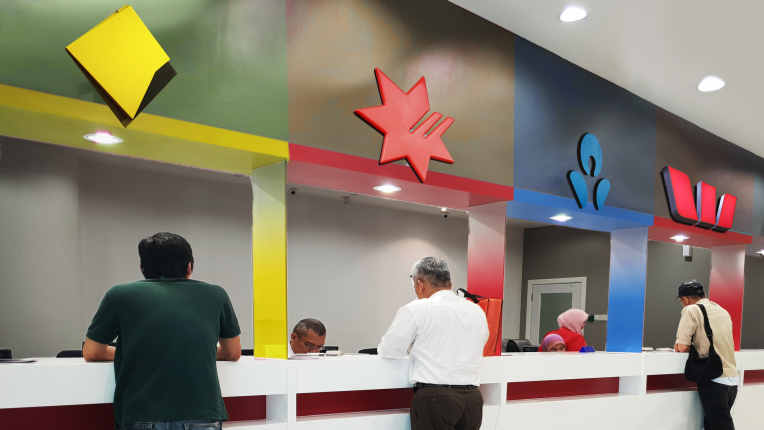'Catch-up rally': banks tower above the rest on ASX
by James FrostThe big four banks have staged a powerful ‘‘catch-up rally’’ in which ANZ and Westpac shares rose 11 per cent in intraday trading, as investors seized on better-than-expected economic news and the fears of an extended downturn subsided.
After missing out on a broad rally in equity markets, prompted by dwindling numbers of fresh COVID-19 cases and the halving of the estimated cost of the JobSeeker package, the combined value of the big four banks swelled by almost $20 billion in just a few hours of feverish trading.

The appetite for bank stocks was also evident in a supersizing of NAB’s retail share purchase plan, which was raised from $750 million to $1.25 billion after strong interest from shareholders. This took the total placement to $4.25 billion, including $3 billion from institutional investors.
After the surge in the middle of the day, trading eased into the close. ANZ shares finished 8.6 per cent higher, CBA 4.9 per cent, NAB 7.8 per cent and Westpac 8 per cent. Retail participants in NAB’s capital raising have made paper gains of 27 per cent in a little less than a week.
While the S&P/ASX 200 Index fell more than 1 per cent through the morning, it recouped the losses by midday as the banks came under strong buying pressure.
However, the index closed down 5.1 points, or 0.1 per cent, at 5775 after the momentum was lost later in the session when stocks dipped on news of protesters in Hong Kong clashing with the police over Beijing's new hardline approach on security.
UBS analyst Jonathan Mott said the banks were due for a ‘‘catch-up rally’’ after the improvement in consumer data, which led many to revise their worst-case predictions.
“Over the past few days, Australia has seen a string of positive economic data as the economy reopens,” Mr Mott said.
He cited retail data, auction clearance rates, the $10.6 billion withdrawn from superannuation and positive trading updates from several small-cap companies among the highlights.
Banks have missed out on the broader market rally, underperforming by 19 per cent over the last three months.
— Jonathan Mott, analyst
“This is all good news, and with the healthcare outcomes continuing to improve, the outlook for the economy is on the rise.”
The data plays directly into expectations for the credit losses the big four are expected to wear over the next three years, which have been as high as $45 billion at times.
Bank watchers will be expecting more data on expected credit losses on Thursday when Bendigo and Adelaide Bank updates the market on its capital position under its Pillar 3 reporting obligations.
Bank shares had been treading water for some weeks now and the sector was trading about 0.8 times book value excluding CBA, according to Mr Mott. The slight change in sentiment released pent-up demand and delivered a sharp relief rally.
“They have missed out on the broader market rally, underperforming by 19 per cent over the last three months. We believe further catch-up is likely near term as the economy reopens,” he said in a note to clients.
Mr Mott said that as the likelihood of a severe downturn receded, “we are certainly not out of the woods”, but “overall we are more optimistic on the banks near term”.
Construction data released on Wednesday, which showed a 1 per cent decline in activity, was not able to dampen the spirits of those looking for a silver lining.
Not all bad news
NAB economist Kaixin Owyong said that although construction in the private sector was down for the seventh consecutive quarter, the overall fall was lower than the bank had forecast.
“Total work done fell by 1 per cent in Q1, a slightly better result than the 1.5 per cent fall forecast by both NAB and the market. This outcome suggests construction activity was not as badly affected by coronavirus restrictions in March as some had feared,” Mr Owyong said.
Commsec’s Craig James was among the economists who pointed out that the fall was most pronounced in NSW, which had its biggest decline in nearly 19 years, plunging 17.3 per cent over the year.
“But it’s not all bad news with all layers of government determined to restart the economy, led by nation-building initiatives,” Mr James said.
He highlighted the strong figures for renovation activity, which rose 2.3 per cent on the quarter as Australians took advantage of the stay-at-home orders.
The benign construction data will play into expectations for first-quarter GDP figures, which are due next Wednesday. NAB is forecasting a 0.2 per cent decline.
Not every economist was convinced that the construction figures contained good news – Westpac Institutional Bank economist Andrew Haslan was more surprised by the composition of the numbers than the headline figure.
Mr Haslan said the 2.5 per cent fall in public works was a surprise to the downside, along with the expected falls in residential construction that had been a feature of the numbers since peaking in mid-2018.
“This dynamic has been a material headwind for growth over this period. The first quarter outcome of 1 per cent lower leaves our view around first-quarter GDP growth unchanged – currently forecasting a decline of 0.7 per cent,” he said.
Economists will be carefully watching Thursday’s release of capital expenditure or business investment numbers for another piece of the ‘‘GDP puzzle’’.